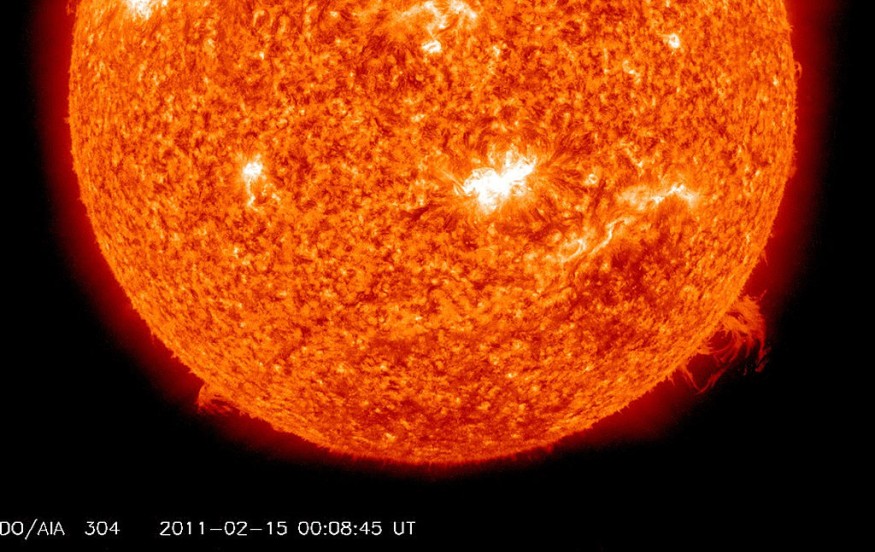Space weather experts are closely monitoring an "enormous sunspot" that doubled in size in the last 24 hours.
The solar surface's hazardous area directly faces Earth. So if it bursts, it will send solar flares our way.
According to Newsweek, sunspots are black regions on the sun's surface related to powerful bursts of radiation. Because they are colder than other portions of the sun's surface, they seem black.
Sunspots are chilly because they grow over locations where the sun's magnetic fields are very strong - so strong that they prevent some of the sun's heat from reaching its surface.

Sunspot Doubles Size in 24 Hours
The sunspot AR3038 was huge and it even grew more prominent.
"The fast-growing sunspot has doubled in size in only 24 hours," said the scientists at SpaceWeather.com.
EarthSky added that low-level C flares continue to erupt from three of the six sunspot areas, AR3030, AR3031, and AR3038. The biggest flare was a C5.7 flare from AR3038 on June 20 at 2:28 am ET (06:28 am UTC).
AR3038 is squarely facing Earth and features an unstable "beta-gamma" magnetic field that stores energy for M-class solar flares.
According to The US Sun, sunspots are dark patches on the sun that form due to magnetism within the burning mass.
They can survive anywhere from a few hours to a few months before breaking down and being termed "dead."
All sunspots do not produce solar flares, but when they occur, they can affect Earth. There's also the possibility that sunspots will produce solar flares that don't reach the planet because the sun sends off a lot of flares into space.
In their study, the astronomers at SpaceWeather.com noted an M-class flare considered medium-intensity. If it impacts Earth, it might create temporary radio blackouts around the planet's poles and cause satellite communication problems.
Solar flares are explosions of solar energy that sometimes strike Earth. They can create varying-intensity solar storms.
Effects of Solar Flare
Reports said solar flares, which are huge blasts of radiation from the Sun's surface that rush into space at incredible speeds, pose a threat from the Sun.
Except for infrequent radio blackouts, humanity is largely unharmed by the Sun's rays thanks to the geomagnetic field and atmosphere, which operate as a regular shield against them.
Communication Implications
Reports said solar flares, which are huge blasts of radiation from the sun's surface that rush into space at incredible speeds, are the sun's biggest threat.
Except for infrequent radio blackouts, humanity is largely unharmed by the sun's rays thanks to the geomagnetic field and atmosphere, which operate as a regular shield against them.
Communication Implications
A massive solar flare could cause a geomagnetic storm that could disrupt online services, mobile phones, satellites, power grids, and other electronic equipment.
Electricity, Internet, and GPS systems might be affected, but solar flares can also hamper regular communication. Everything, including phone calls and Internet access, is disrupted.
And because fixing the wrecked and damaged infrastructure will take a long time, it might remain down for months.
Aurora
Auroras are produced by these solar storms and are quite attractive. The northern lights, often known as auroras, may put on a spectacular show in the sky.
The polar lights are created when charged particles from the sun are caught in the Earth's magnetic field and transmitted to the Ionosphere. NASA describes how those fascinating lights in the sky are made on the poles.
Geomagnetic Storm
According to Britannica, a geomagnetic storm is a disruption of Earth's upper atmosphere caused by coronal mass ejection from the sun's outer atmosphere, or corona.
Most of the material involved in these eruptions is made up of charged particles with an energy of a few thousand electron volts.
Plasma moves at speeds ranging from less than 10 km (6 miles) per second to more than 2,000 km (1,200 miles) per second through the interplanetary medium, taking roughly 21 hours to reach Earth.
The pressure of the incoming plasma is transferred to the outer edge of the Earth's magnetosphere, increasing the visible Earth's magnetic field at the ground, potentially via hydromagnetic waves.
During the storm's brief sudden-commencement phase, the Earth's magnetic field's horizontal component develops rapidly throughout the globe.
The storm's early phase is characterized by the spike, which lasts two to six hours. In response to this unstable environment, the newly formed magnetic lines in the tail's core compress quickly, forcing plasma from the geomagnetic's neutral sheet toward Earth's night side.
The contractions in the polar regions result in powerful auroral displays, while the contractions on Earth result in a severe magnetic disturbance known as a polar substorm.
The major phase of the storm, which lasts 12 to 48 hours and is defined by the horizontal component, follows.
RELATED ARTICLE : Solar Storm Warning: Flares Are Heading Towards the Earth, Could It Take Down Communications Lines Worldwide?
Check out more news and information on Space in Science Times.
© 2025 ScienceTimes.com All rights reserved. Do not reproduce without permission. The window to the world of Science Times.












